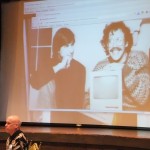On 10 August 1987—twenty-five years ago yesterday—Apple Computer unveiled a revolutionary new program called HyperCard. Tonight the Hillside Club in Berkeley hosted a 25th anniversary celebration of HyperCard, with BMUG co-founder Raines Cohen interviewing Bill Atkinson with a large crowd of grizzled computer geeks in attendance.
Soon after HyperCard’s Boston debut, developer Bill Atkinson demonstrated his new program to the Berkeley Macintosh User’s Group. At its peak, BMUG was the largest user group in the country with over 13,000 members, and gave away book-sized “newsletters” each year stuffed with free software. I was in the BMUG audience that night, inside the Physical Sciences Lecture Hall (now Pimentel Hall) on the UC Berkeley campus—the same cavernous room where I had taken chemistry from Dr George Pimentel a decade before. The image that sticks in my head was Bill displaying a picture of a fish and clicking on the fish’s eye, which immediately jumped to other eyes on other pictures.
Atkinson was already famous among Macintosh afficionados, as he had written both QuickDraw and MacPaint for the original Apple Macintosh in 1983. One might say that HyperCard version zero of the World Wide Web: a program whose raison d’etre was creating links between various elements in a database. Tim Berners-Lee drew upon this concept when he invented HTTP, and computing has never looked back.
My personal favorite stepchild of HyperCard was the game Myst. I’m not a gamer, but I was captivated by the evocative landscapes, steampunk and spaceships, all with a fantastic soundtrack. Atkinson’s own favorite stepchild was his iOS app PhotoCard, an attempt to save the postcard from extinction by offering a postcard delivery service. Bill is a talented nature photographer and edits many of PhotoCard’s images himself.




